Economic Impact of Organic Agriculture: Evidence from a Pan-India Survey
Abstract
1. Introduction
- To understand the effect of the organic agriculture in terms of costs, yields and profitability of farmers using the Difference-in-Difference approach in India, as well as rainfed and hilly areas.
- To assess the economy-wide impacts of organic agriculture using the economic surplus model.
- To evaluate the project implementation bottlenecks of the organic agriculture scheme in India.
2. Sampling Framework and Methodology
3. Results and Analysis
3.1. Theory of Change
3.2. Implementation Bottlenecks at the Cluster Level
3.3. Procedures for Certification
3.4. Facilities and Infrastructure at the Cluster Level
3.5. Preparation and Use of Bio-Inputs
3.6. Impact Assessment of PKVY at Farm Level
3.7. Impact of PKVY at the Macro Level
3.8. Farmer’s Attitude toward Organic Farming
3.9. Constraints in PKVY Programme Implementation
4. Implementation Bottlenecks and Gaps at Macro-Level
Fund Allocation and Utilization
5. Policy Analysis and Conclusions
Author Contributions
Funding
Institutional Review Board Statement
Informed Consent Statement
Data Availability Statement
Acknowledgments
Conflicts of Interest
Appendix A
Appendix A.1. Difference-in-Difference (DID) Model
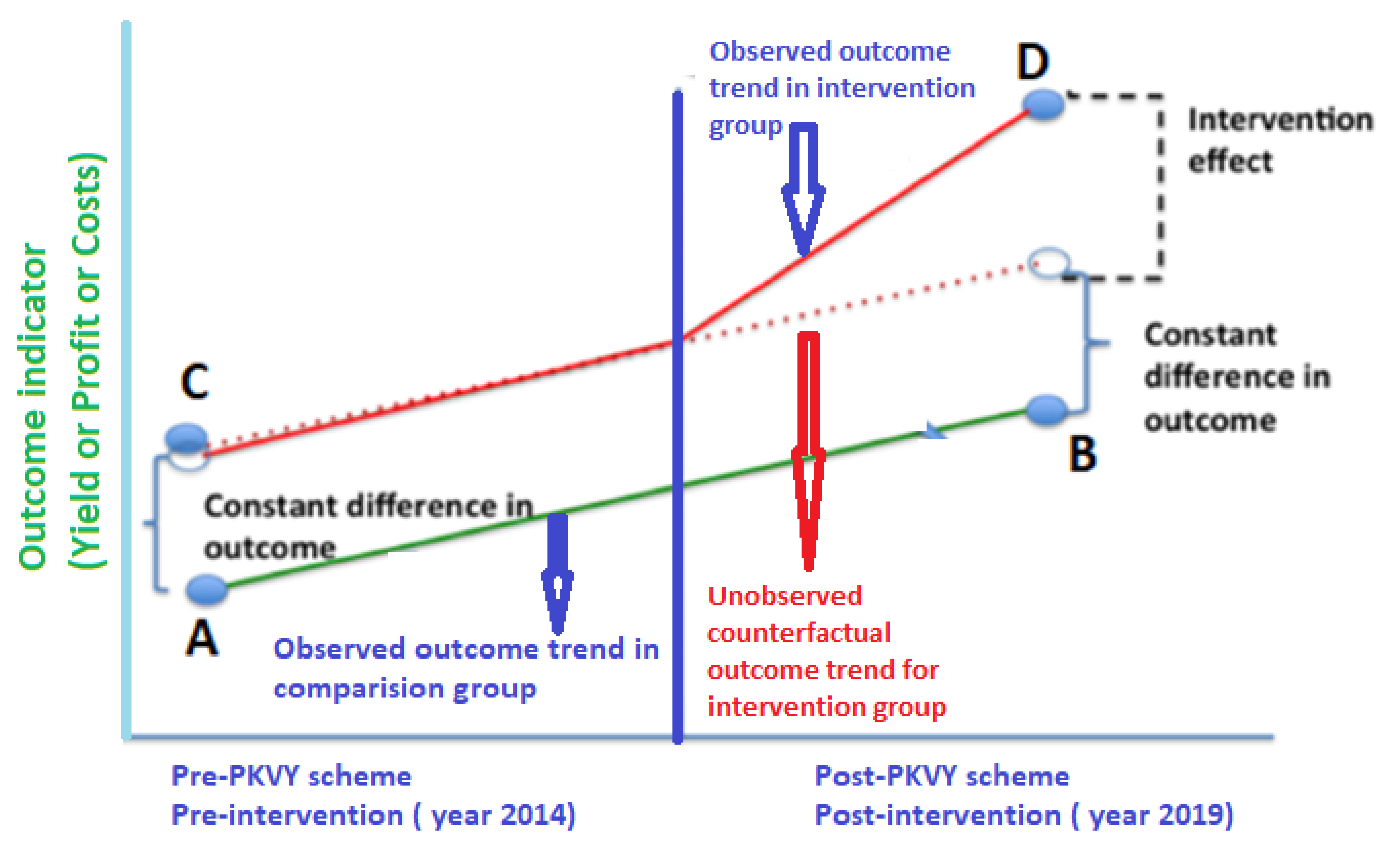
| Calculation | Interpretation | |
|---|---|---|
| Β0 | A | Base year outcome control group (year 2014) |
| Β1 | B–A | Time trend in control group (conventional agriculture) |
| Β2 | C–A | Difference between the two groups in pre-intervention (in year 2014) |
| Β3 | (D–B)–(C–A) | Impact of organic agriculture: Difference in change of outcome over time with the adoption of organic agriculture, after discounting initial differences. |
Appendix A.2. Economic Surplus Approach
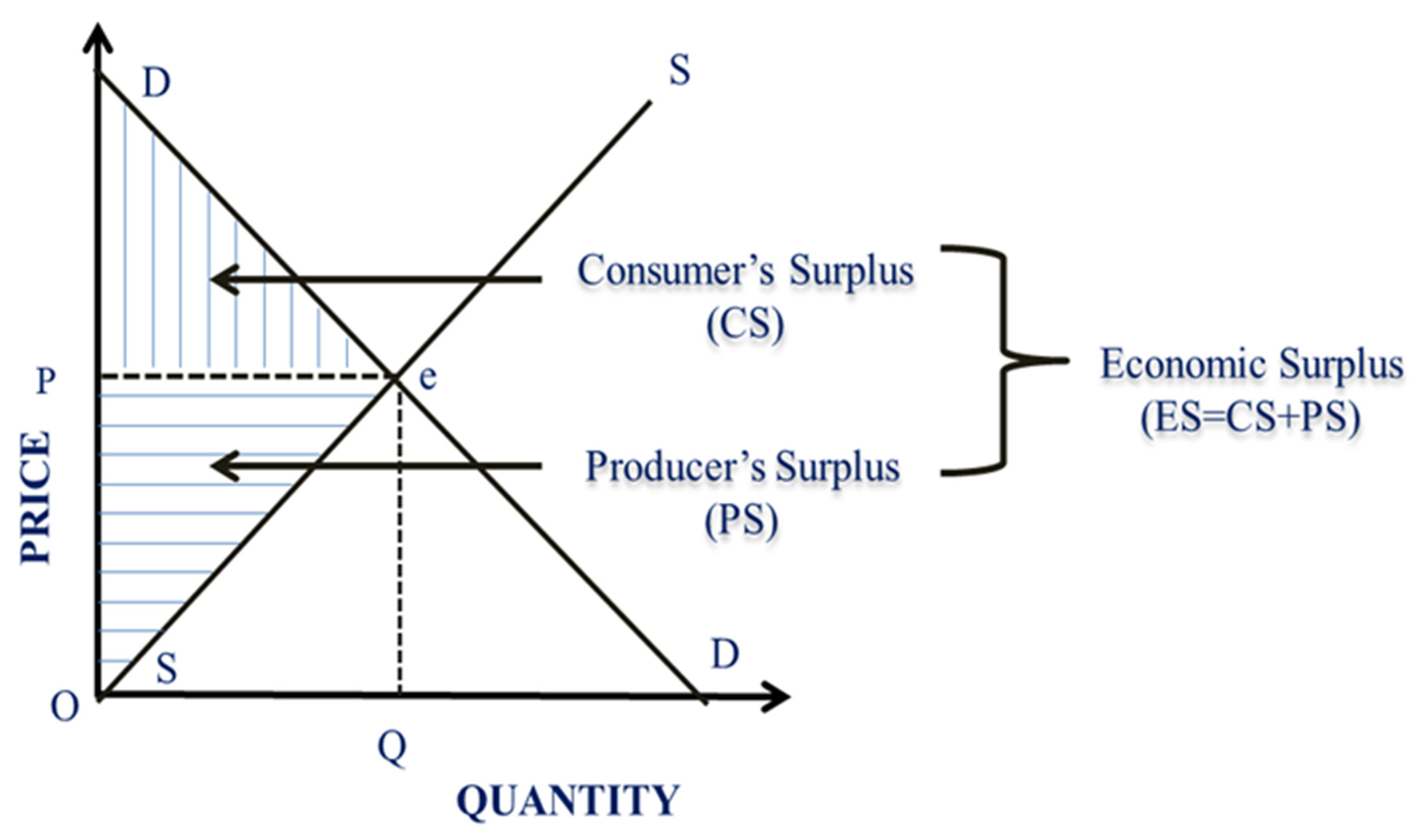
Closed Economy with Parallel Supply Shift
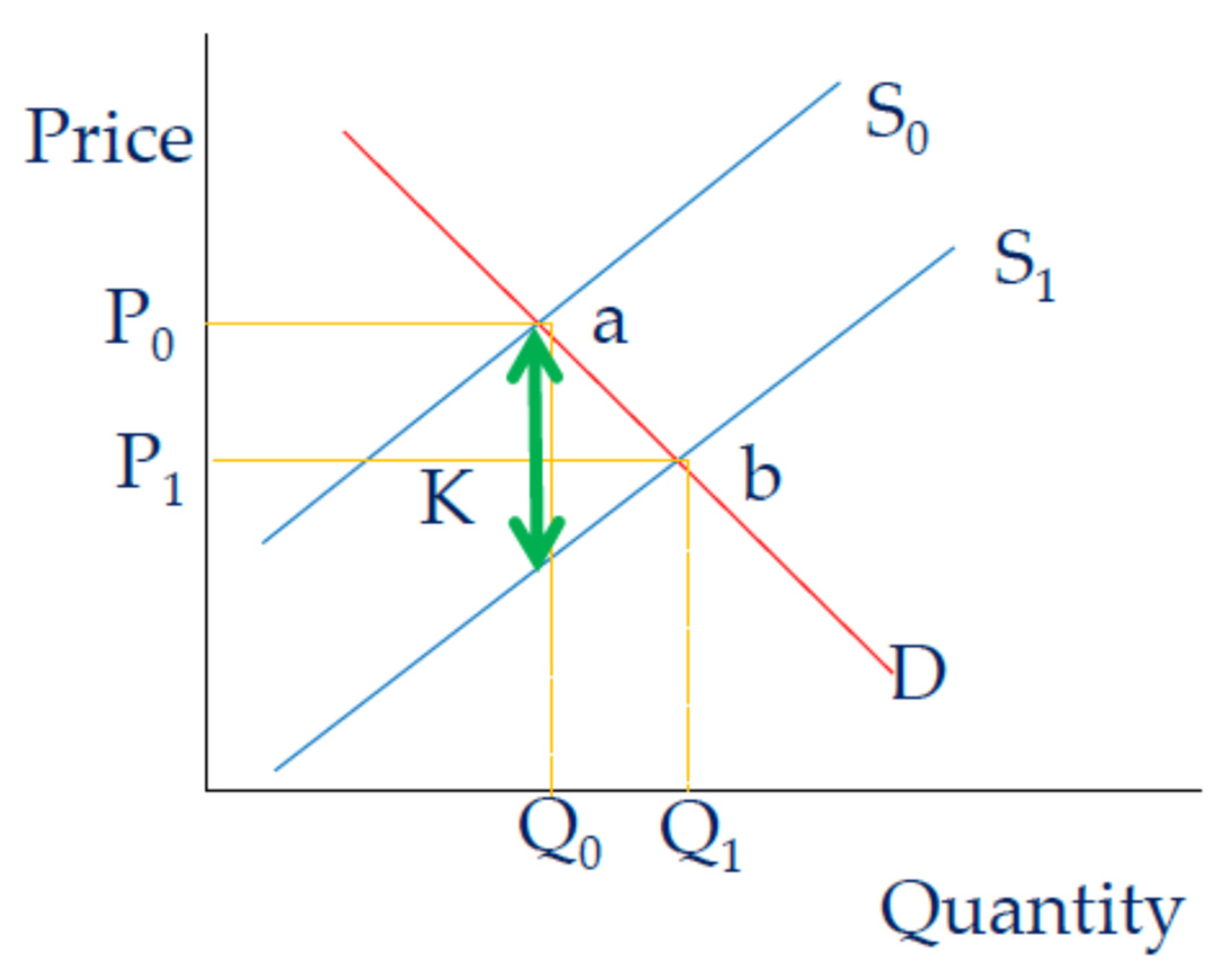
References
- Reganold, J.P.; Wachter, J.M. Organic agriculture in the twenty-first century. Nat. Plants 2016, 2, 15221. [Google Scholar] [CrossRef] [PubMed]
- Khangan, M. Organic Food And Beverages Market Size to Reach USD 620.00 Billion by 2026, Globally. Food Beverages, 18 September 2020; 1–220. [Google Scholar]
- Liang, B.; Scammon, D.L. Food contamination incidents: What do consumers seek online? Who cares? Int. J. Nonprofit Volunt. Sect. Mark. 2016, 21, 227–241. [Google Scholar] [CrossRef]
- Aschemann-Witzel, J.; Ares, G.; Thøgersen, J.; Monteleone, E. A sense of sustainability?—How sensory consumer science can contribute to sustainable development of the food sector. Trends Food Sci. Technol. 2019, 90, 180–186. [Google Scholar] [CrossRef]
- Janssen, M. Determinants of organic food purchases: Evidence from household panel data. Food Qual. Prefer. 2018, 68, 19–28. [Google Scholar] [CrossRef]
- Willer, H.; Lernoud, J.; Huber, B.; Sahota, A. The world of organic agriculture. Statistics and emerging trends 2019 at BIOFACH 2019. In Proceedings of the BIOFACH Congress 2019, Nuremberg, Germany, 13–16 February 2019; pp. 1–336. [Google Scholar]
- Patil, S.; Reidsma, P.; Shah, P.; Purushothaman, S.; Wolf, J. Comparing conventional and organic agriculture in Karnataka, India: Where and when can organic farming be sustainable? Land Use Policy 2014, 37, 40–51. [Google Scholar] [CrossRef]
- Zander, K.; Hamm, U. Consumer preferences for additional ethical attributes of organic food. Food Qual. Prefer. 2010, 21, 495–503. [Google Scholar] [CrossRef]
- Tilman, D.; Cassman, K.G.; Matson, P.A.; Naylor, R.; Polasky, S. Agricultural sustainability and intensive production practices. Nature 2002, 418, 671. [Google Scholar] [CrossRef]
- Vojir, F.; Schübl, E.; Elmadfa, I. The origins of a global standard for food quality and safety: Codex Alimentarius Austriacus and FAO/WHO Codex Alimentarius. Int. J. Vitam. Nutr. Res. 2012, 82, 223. [Google Scholar] [CrossRef]
- Meemken, E.M.; Qaim, M. Organic agriculture, food security, and the environment. Annu. Rev. Resour. Econ. 2018, 10, 39–63. [Google Scholar] [CrossRef]
- Sri Lanka’s Plunge Into Organic Farming Brings Disaster. New York Times. 7 December 2021. Available online: https://www.nytimes.com/2021/12/07/world/asia/sri-lanka-organic-farming-fertilizer.html (accessed on 1 February 2022).
- Röös, E.; Mie, A.; Wivstad, M.; Salomon, E.; Johansson, B.; Gunnarsson, S.; Wallenbeck, A.; Hoffmann, R.; Nilsson, U.; Sundberg, C.; et al. Risks and opportunities of increasing yields in organic farming. A review. Agron. Sustain. Dev. 2018, 38, 14. [Google Scholar] [CrossRef]
- Smith, O.M.; Cohen, A.L.; Rieser, C.J.; Davis, A.G.; Taylor, J.M.; Adesanya, A.W.; Jones, M.S.; Meier, A.R.; Reganold, J.P.; Orpet, R.J.; et al. Organic Farming Provides Reliable Environmental Benefits but Increases Variability in Crop Yields: A Global Meta-Analysis. Front. Sustain. Food Syst. 2019, 3, 82. [Google Scholar] [CrossRef]
- Van Der Werf, H.M.G.; Knudsen, M.T.; Cederberg, C. Towards better representation of organic agriculture in life cycle assessment. Nat. Sustain. 2020, 3, 419–425. [Google Scholar] [CrossRef]
- Qiao, Y.; Martin, F.; Cook, S.; He, X.; Halberg, N.; Scott, S.; Pan, X. Certified Organic Agriculture as an Alternative Livelihood Strategy for Small-scale Farmers in China: A Case Study in Wanzai County, Jiangxi Province. Ecol. Econ. 2018, 145, 301–307. [Google Scholar] [CrossRef]
- Froehlich, A.G.; Melo, A.S.; Sampaio, B. Comparing the Profitability of Organic and Conventional Production in Family Farming: Empirical Evidence From Brazil. Ecol. Econ. 2018, 150, 307–314. [Google Scholar] [CrossRef]
- Knapp, S.; Van Der Heijden, M.G.A. A global meta-analysis of yield stability in organic and conservation agriculture. Nat. Commun. 2018, 9, 3632. [Google Scholar] [CrossRef] [PubMed]
- Ahmed, N.; Thompson, S.; Turchini, G.M. Organic aquaculture productivity, environmental sustainability, and food security: Insights from organic agriculture. Food Secur. 2020, 12, 1253–1267. [Google Scholar] [CrossRef]
- Funk, C.; Kennedy, B. The New Food Fights: US Public Divides over Food Science; Pew Research Centre: Washington, DC, USA, 2016. [Google Scholar]
- APEDA. Organic Products. 2020. Available online: http://apeda.gov.in/apedawebsite/organic/Organic_Products.htm#:~:text=India%20produced%20around%202.75%20million,%2C%20Vegetables%2C%20Processed%20foods%20etc (accessed on 22 February 2022).
- NCOF. Annual Report (2016–17); National Centre of Organic Farming, Ministry of Agriculture and Farmers Welfare, GoI: New Delhi, India, 2017.
- GoI. Zonal Councils. Ministry of Home Affairs, Government of India. 2022. Available online: https://www.mha.gov.in/sites/default/files/ZCS-CitiCharter-130710_1.pdf (accessed on 20 June 2022).
- Reddy, A.A. Impact Study of Paramparagat Krishi Vikas Yojana. National Institute of Agricultural Extension Management (MANAGE), Hyderabad-500030. 2017; p. 210. Available online: http://www.manage.gov.in/publications/reports/pkvy.pdf (accessed on 2 November 2019).
- Dandona, L.; Dandona, R.; Kumar, G.A.; Shukla, D.K.; Paul, V.K.; Balakrishnan, K.; Prabhakaran, D.; Tandon, N.; Salvi, S.; Dash, A.P.; et al. Nations within a nation: Variations in epidemiological transition across the states of India, 1990–2016 in the Global Burden of Disease Study. Lancet 2017, 390, 2437–2460. [Google Scholar] [CrossRef]
- Khanna, R.; Sharma, C. Do infrastructure and quality of governance matter for manufacturing productivity? Empirical evidence from the Indian states. J. Econ. Stud. 2018, 45, 829–854. [Google Scholar] [CrossRef]
- Kumbhakar, S.C.; Tsionas, E.G.; Sipiläinen, T. Joint estimation of technology choice and technical efficiency: An application to organic and conventional dairy farming. J. Product. Anal. 2009, 31, 151–161. [Google Scholar] [CrossRef]
- Greenwood, P.E.; Nikulin, M.S. A Guide to Chi-Squared Testing; John Wiley & Sons: Hoboken, NJ, USA, 1996; Volume 280. [Google Scholar]
- Reddy, A.; Reddy, G.P. Supply side constrains in production of pulses in India: Case study of lentils. Agric. Econ. Res. Rev. 2010, 23, 129–136. [Google Scholar]
- Rogers, P.J. Using programme theory to evaluate complicated and complex aspects of interventions. Evaluation 2008, 14, 29–48. [Google Scholar] [CrossRef]
- Rogers, P.J. Theory of Change: Methodological Briefs-Impact Evaluation No. 2; UNICEF Office of Research: Florence, Spain, 2014. [Google Scholar]
- Benbi, D.K. Carbon footprint and agricultural sustainability nexus in an intensively cultivated region of Indo-Gangetic Plains. Sci. Total Environ. 2018, 644, 611–623. [Google Scholar] [CrossRef] [PubMed]
- He, X.Q.; Qiao, Y.H.; Liang, L.; Knudsen, M.T.; Martin, F. Environmental life cycle assessment of long-term organic rice production in subtropical China. J. Clean. Prod. 2018, 176, 880–888. [Google Scholar] [CrossRef]
- Heckelman, A.; Smukler, S.; Wittman, H. Cultivating climate resilience: A participatory assessment of organic and conventional rice systems in the Philippines. Renew. Agric. Food Syst. 2018, 33, 225–237. [Google Scholar] [CrossRef]
- Rani, V.U.; Reddy, G.P.; Prasad, Y.E.; Reddy, A. Competitiveness of major crops in post-WTO period in Andhra Pradesh. Indian J. Agric. Econ. 2014, 69, 125–141. [Google Scholar] [CrossRef]
- Kumar, P.; Kumar, A.; Parappurathu, S.; Raju, S.S. Estimation of Demand Elasticity for Food Commodities in India. Agric. Econ. Res. Rev. 2011, 24, 1–14. [Google Scholar]
- Chetsumon, S. Attitudes of Extension Agents towards Expert Systems as Decision Support Tools in Thailand. Ph.D. Thesis, Lincoln University, Canterbury, New Zealand, 2005. [Google Scholar]
- Wheeler, S.A. What influences agricultural professionals’ views towards organic agriculture? Ecol. Econ. 2008, 65, 145–154. [Google Scholar] [CrossRef]
- Chou, Y.M.; Shen, F.T.; Chiang, S.C.; Chang, C.M. Functional diversity and dominant populations of bacteria in banana plantation soils as influenced by long-term organic and conventional farming. Appl. Soil Ecol. 2017, 110, 21–33. [Google Scholar] [CrossRef]
- Hokazono, S.; Hayashi, K. Variability in environmental impacts during conversion from conventional to organic farming: A comparison among three rice production systems in Japan. J. Clean. Prod. 2012, 28, 101–112. [Google Scholar] [CrossRef]
- Hou, W.S.; Chang, Y.H.; Chuang, T.F.; Chen, C.H. Effect of ecological engineering design on biological motility and habitat environment of Hynobiusarisanensis at high altitude areas in Taiwan. Ecol. Eng. 2010, 36, 791–798. [Google Scholar] [CrossRef]
- Parliament of India. Report of Organic Products: Challenges and Opportunities; Standing Committee on Commerce, Parliament of India: New Delhi, India, 11 December 2019. [Google Scholar]
- Sharma, O.P.; Garg, D.K.; Trivedi, T.P.; Chahar, S.; Singh, S.P. Evaluation of pest management strategies in organic and conventional Taraori basmati rice (Oryza sativa) farming system. Indian J. Agric. Sci. 2008, 78, 862–867. [Google Scholar]
- Sihi, D.; Dari, B.; Sharma, D.K.; Pathak, H.; Nain, L.; Sharma, P. Evaluation of soil health in organic vs. conventional farming of basmati rice in North India. J. Plant Nutr. Soil Sci. 2017, 180, 389–406. [Google Scholar] [CrossRef]
- Tashi, S.; Wangchuk, K. Organic vs conventional rice production: Comparative assessment under farmers’ condition in Bhutan. Org. Agric. 2016, 6, 255–265. [Google Scholar] [CrossRef]
- Jouzi, Z.; Azadi, H.; Taheri, F.; Zarafshani, K.; Gebrehiwot, K.; Van Passel, S.; Lebailly, P. Organic farming and small-scale farmers: Main opportunities and challenges. Ecol. Econ. 2017, 132, 144–154. [Google Scholar] [CrossRef]
- Kaje, V.V.; Sharma, D.K.; Shivay, Y.S.; Jat, S.L.; Bhatia, A.; Purakayastha, T.J.; Bandyopadhyay, K.K.; Bhattacharyya, R. Long-term impact of organic and conventional farming on soil physical properties under rice (Oryza sativa)-wheat (Triticum aestivum) cropping system in north-western indo-Gangetic plains. Indian J. Agric. Sci. 2018, 88, 107–113. [Google Scholar]
- Katayama, N.; Osada, Y.; Mashiko, M.; Baba, Y.G.; Tanaka, K.; Kusumoto, Y.; Okubo, S.; Ikeda, H.; Natuhara, Y. Organic farming and associated management practices benefit multiple wildlife taxa: A large-scale field study in rice paddy landscapes. J. Appl. Ecol. 2019, 56, 1970–1981. [Google Scholar] [CrossRef]
- Kumar, K.A.; Swain, D.K.; Pallavi, G.B.C. Effect of organic and inorganic nutrient management on soil nutrient dynamics and productivity of rice-chickpea system in lateritic soil. Org. Agric. 2018, 8, 15–28. [Google Scholar] [CrossRef]
- Das, A.; Patel, D.P.; Kumar, M.; Ramkrushna, G.I.; Mukherjee, A.; Layek, J.; Ngachana, S.V.; Buragohain, J. Impact of seven years of organic farming on soil and produce quality and crop yields in eastern Himalayas, India. Agric. Ecosyst. Environ. 2017, 236, 142–153. [Google Scholar] [CrossRef]
- Lu, H.; Chang, Y.; Wu, B. The compare organic farm and conventional farm to improve sustainable agriculture, ecosystems, and environment. Org. Agric. 2020, 10, 409–418. [Google Scholar] [CrossRef]
- Seufert, V.; Ramankutty, N. Many shades of grey—The context-dependent performance of organic agriculture. Sci. Adv. 2017, 3, e1602638. [Google Scholar] [CrossRef]
- Rigby, D.; Caceres, D. Organic Farming and the Sustainability of Agricultural Systems. Agric. Syst. 2001, 68, 21–40. [Google Scholar] [CrossRef]
- Alves, G.H.; Paraginski, R.T.; Lamas, N.D.; Hoffmann, J.F.; Vanier, N.L.; de Oliveira, M. Effects of organic and conventional cropping systems on technological properties and phenolic compounds of freshly harvested and stored rice. J. Food Sci. 2017, 82, 2276–2285. [Google Scholar] [CrossRef] [PubMed]
- Cherukuri, R.R.; Reddy, A.A. Producer organisations in Indian agriculture: Their role in improving services and intermediation. South Asia Res. 2014, 34, 209–224. [Google Scholar] [CrossRef]
- Ponti, T.; Rijk, B.; Van Ittersum, M.K. The crop yield gap between organic and conventional agriculture. Agric. Syst. 2012, 108, 1–9. [Google Scholar] [CrossRef]
- Helga, W.; Trávníček, J.; Meier, C.; Schlatter, B. (Eds.) The World of Organic Agriculture. Statistics and Emerging Trends 2022; Research Institute of Organic Agriculture FiBL: Frick, switzerland; IFOAM—Organics International: Bonn, Germany, 2022. [Google Scholar]
- Seufert, V.; Amankutty, N.; Foley, J.A. Comparing the yields of organic and conventional agriculture. Nature 2012, 485, 229. [Google Scholar] [CrossRef] [PubMed]
- Reddy, A.A. The soil health card Scheme in India: Lessons learned and challenges for replication in other developing countries. J. Nat. Resour. Policy Res. 2019, 9, 124–156. [Google Scholar] [CrossRef]
- Alston, J.M.; James, J.S. The incidence of agricultural policy. Handb. Agric. Econ. 2002, 2, 1689–1749. [Google Scholar]
- Nikam, V.; Kumar, S.; Kingsly, I.T. Impact assessment of mobile app using Economic Surplus Model. Indian J. Agric. Sci. 2019, 89, 1039–1043. [Google Scholar]
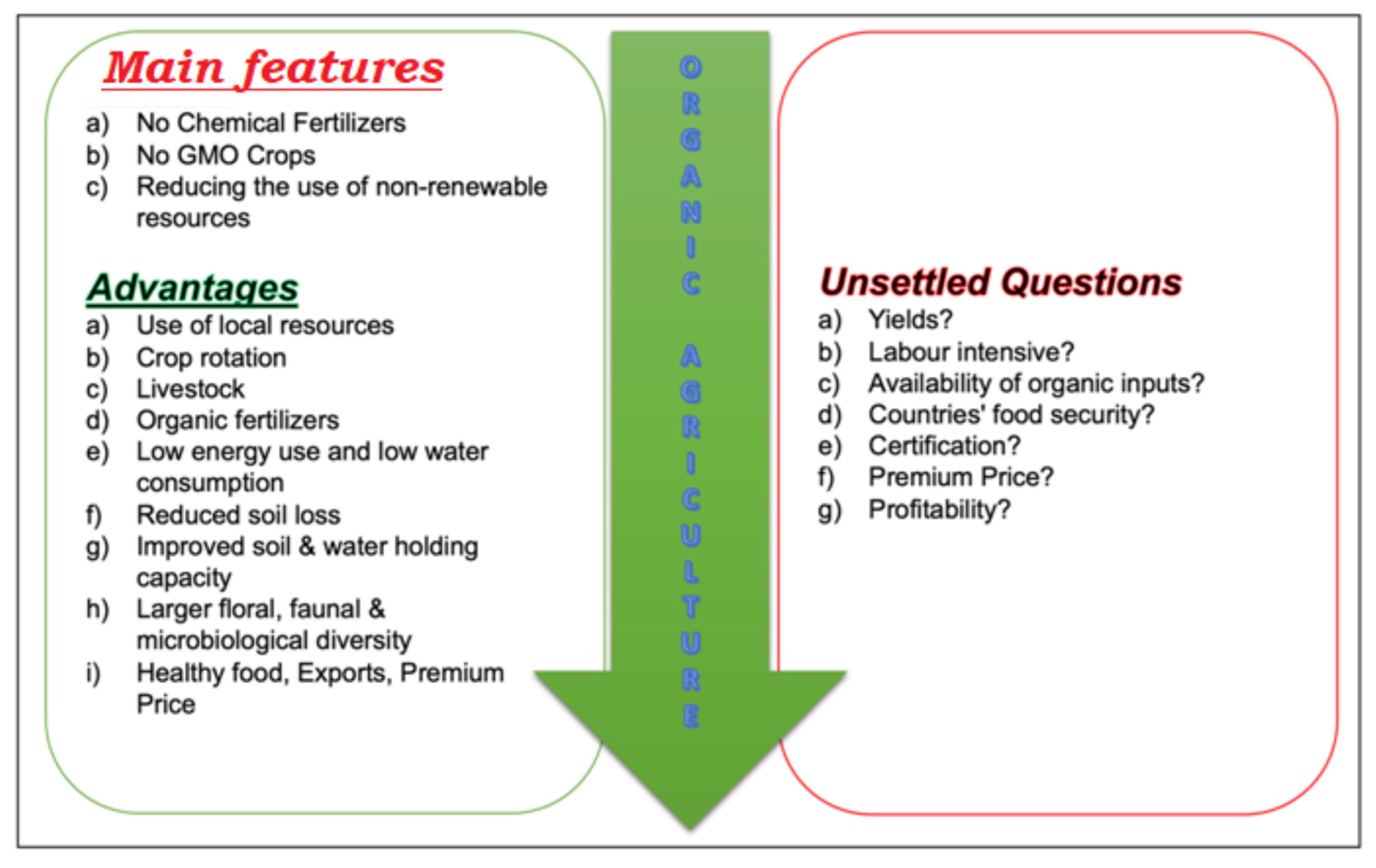


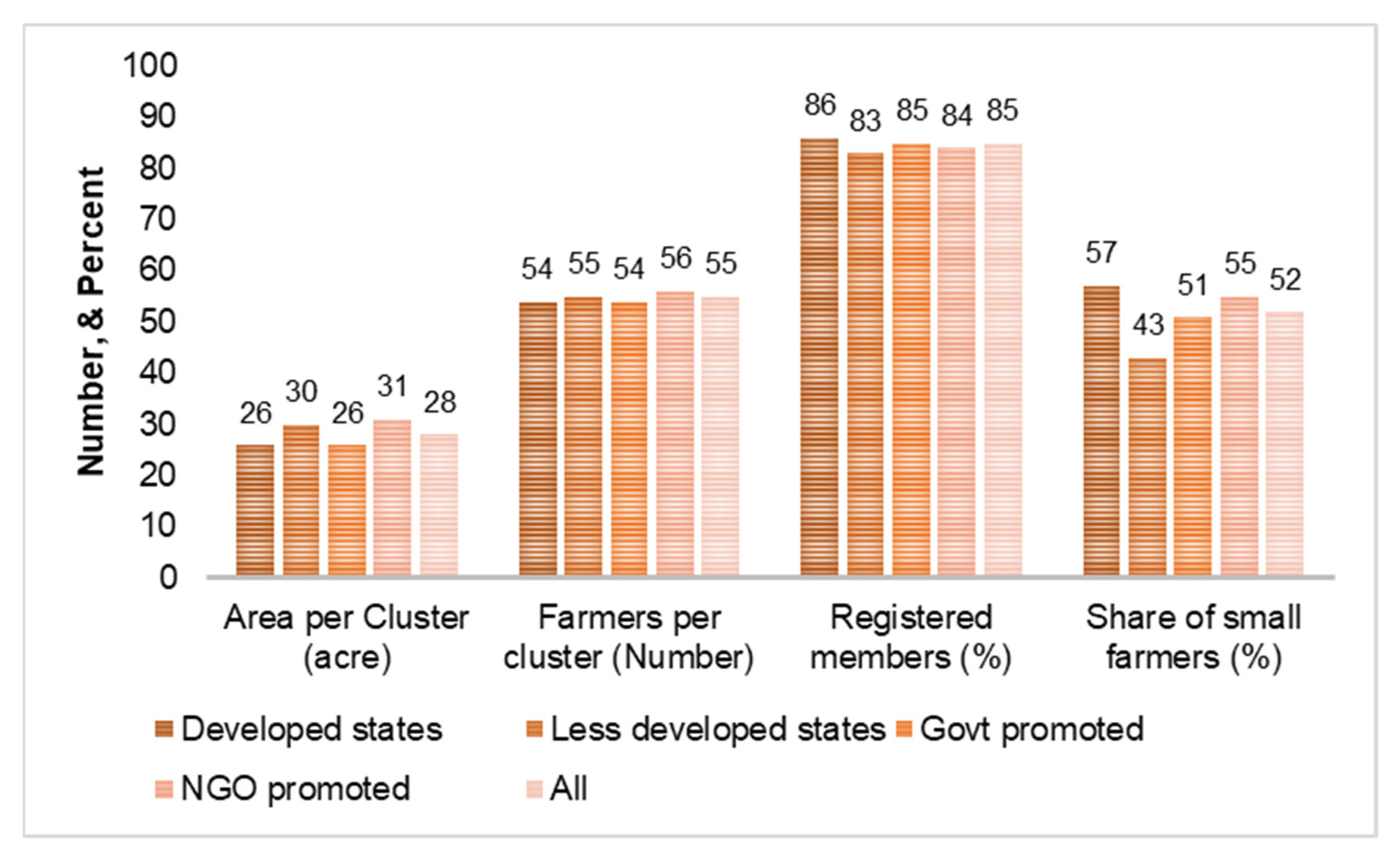
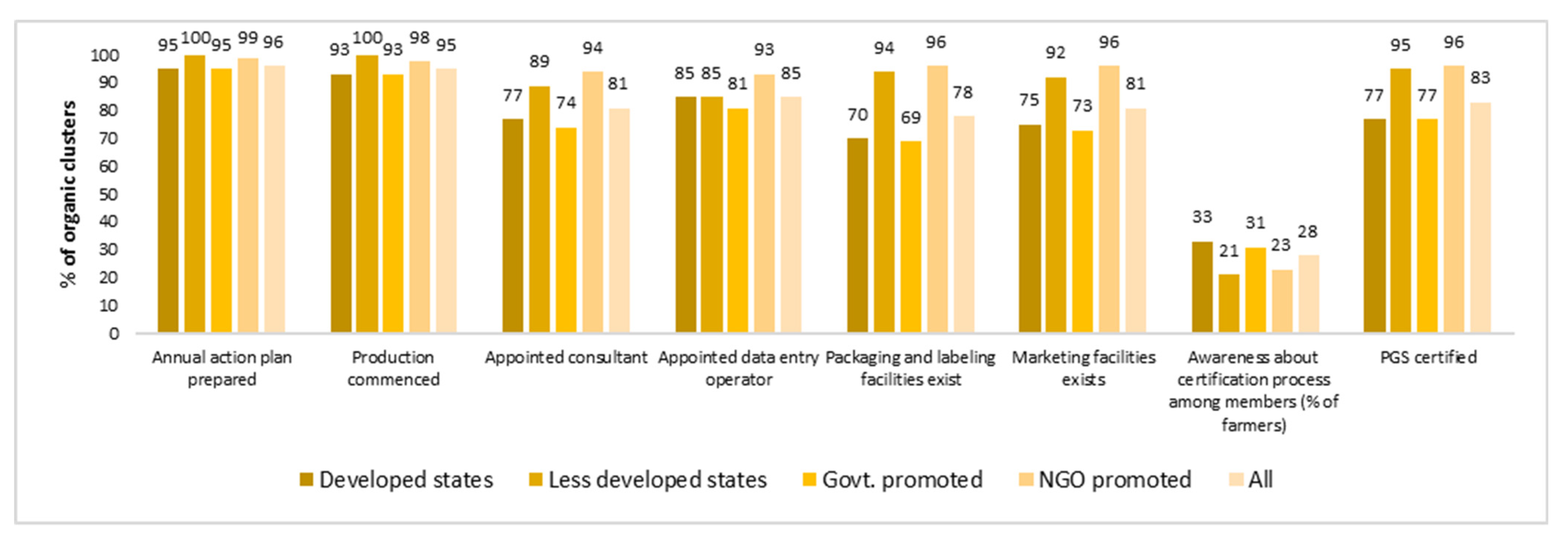
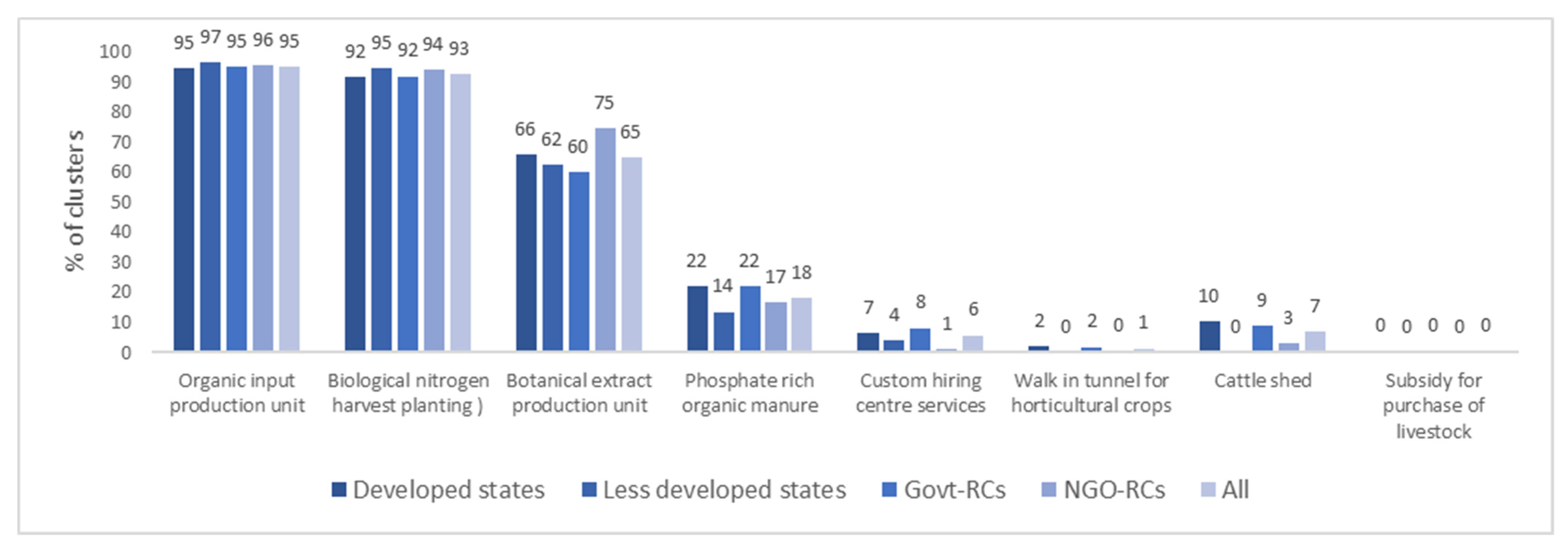


| Criteria | State Category | Management of RCs | All | ||
|---|---|---|---|---|---|
| Cluster Group | Developed | Less Developed | Govt. | Non-Govt. | |
| Organic Seed | 6.3 | 19.9 * | 6.3 | 19.9 * | 13.8 |
| Green Manure | 55.0 | 76.8 * | 52.0 | 79.3 * | 67.0 |
| Compost | 37.0 | 69.7 * | 34.0 | 72.2 * | 55.0 |
| Bio-Fertilizer (other than green manure and compost) | 9.0 | 12.1 | 7.2 | 13.6 | 10.7 |
| Bio-pesticide | 8.0 | 15.3 * | 6.5 | 16.5 * | 12.0 |
| Panchamruth | 8.8 | 13.2 * | 5.4 | 15.9 * | 11.2 |
| Panchagavya | 6.4 | 21.2 * | 4.3 | 22.8 * | 14.5 |
| Beejamruth | 5.1 | 12.2 * | 4.5 | 12.7 * | 9.0 |
| Drip Irrigation | 2.5 | 1.0 | 3.1 | 0.6 | 1.7 |
| Wheat | Paddy | Soybean | ||||||||
|---|---|---|---|---|---|---|---|---|---|---|
| Conventional Farmers | Organic Farmers | Impact of Organic Agriculture (Double Difference) | Conventional Farmers | Organic Farmers | Impact of Organic Agriculture (Double Difference) | Conventional Farmers | Organic Farmers | Impact of Organic Agriculture (Double Difference) | ||
| Cost (Rs/ha) | Before | 40,008 | 40,059 | 49,017 | 48,347 | 27,874 | 27,000 | |||
| After | 48,202 | 42,752 | 60,742 | 51,598 | 33,183 | 27,468 | ||||
| % change | 20.5 | 6.7 | −13.7 | 23.9 | 6.7 | −17.3 | 19.0 | 1.7 | −17.4 | |
| Gross revenue (Rs/ha) | Before | 50,796 | 51,304 | 59,269 | 59,861 | 31,954 | 32,274 | |||
| After | 61,200 | 56,228 | 71,408 | 64,105 | 37,771 | 33,380 | ||||
| % change | 20.5 | 9.6 | −10.8 | 20.5 | 7.1 | −13.3 | 18.2 | 3.4 | −14.7 | |
| Profit (gross revenue- costs) (Rs/ha) | Before | 10,788 | 11,245 | 10,252 | 11,514 | 4081 | 5274 | |||
| After | 12,998 | 13,476 | 10,666 | 12,507 | 4588 | 5912 | ||||
| % change | 20.5 | 19.8 | 0.2 | 4.0 | 8.6 | 5.6 | 12.4 | 12.1 | 3.2 | |
| Yield (Rs/ha) | Before | 35.3 | 35.3 | 39.0 | 39.0 | 11.8 | 11.8 | |||
| After | 36.0 | 31.5 | 41.0 | 33.9 | 12.0 | 10.1 | ||||
| % change | 2.0 | −10.7 | −12.8 | 5.1 | −13.1 | −18.2 | 2.0 | −14.1 | −16.2 | |
| Manure (quintal/ha) | Before | 4.0 | 4.0 | 12.0 | 12.0 | 5.0 | 5.0 | |||
| After | 4.0 | 6.0 | 12.0 | 15.0 | 5.0 | 6.0 | ||||
| % change | 0.0 | 50.0 | 50.0 | 0.0 | 25.0 | 25.0 | 0.0 | 20.0 | 20.0 | |
| Overall Sample | Sub Sample of Rainfed, Tribal and Hilly Areas | |||||
|---|---|---|---|---|---|---|
| Wheat | Paddy | Soybean | Wheat | Paddy | Soybean | |
| Cost (Rs/ha) (Dependent variable) | ||||||
| (Constant) | 40,008 | 49,017 | 27,874 | 30,006 | 36,763 | 20,905 |
| Time | 8194 | 11,725 | 5309 | 7785 | 9713 | 5150 |
| Intervention | 51 | −670 | −874 | 48 | −863 | −743 |
| Intervention ∗ Time | −5501 * | −8474 * | −4841 * | −4291 * | −6610 * | −3776 * |
| R2 | 0.84 | 0.86 | 0.78 | 0.76 | 0.77 | 0.67 |
| Profit(Rs/ha) (Dependent variable) | ||||||
| (Constant) | 10,788 | 10,252 | 4081 | 8091 | 7689 | 3060 |
| Time | 2210 | 414 | 507 | 2099 | 455 | 492 |
| Intervention | 457 | 1262 | 1193 | 474 | −18 | 435 |
| Intervention ∗ Time | 21 | 579 | 3436 | 16 | 451 | 2680 * |
| R2 | 0.81 | 0.83 | 0.75 | 0.73 | 0.74 | 0.67 |
| Yield (Quintal/ha) (Dependent variable) | ||||||
| (Constant) | 35.3 | 39.0 | 11.8 | 26 | 29 | 9 |
| Time | 0.7 | 2.0 | 0.2 | 0.8 | 2.2 | 0.2 |
| Intervention | 0.0 | 0.0 | 0.0 | 0 | 0 | 0 |
| Intervention ∗ Time | −4.5 | −7.1 | −0.9 | −1.3 * | −2.0 * | −0.5 |
| R2 | 0.81 | 0.83 | 0.76 | 0.73 | 0.75 | 0.68 |
| Number of sample | 1210 | 1814 | 337 | 242 | 544 | 202 |
| Crop | 10% Area under Organic | 30% Area under Organic | ||||||
|---|---|---|---|---|---|---|---|---|
| Total Production (MT) | Value of Production (Rs. Billion) | Total Surplus | Consumer Surplus | Producer Surplus | Total Surplus | Consumer Surplus | Producer Surplus | |
| Change in Rs. billion | ||||||||
| Paddy | 109.0 | 1744 | −26.6 | −17.8 | −8.8 | −79.5 | −53.2 | −26.3 |
| Wheat | 98.5 | 1773 | −17.5 | −10.4 | −7.1 | −52.5 | −31.2 | −21.2 |
| Soybean | 13.1 | 408 | −4.5 | −2.3 | −2.3 | −13.6 | −6.8 | −6.8 |
| Change in Rs. billion (shift confined to rainfed, hilly and tribal areas only) | ||||||||
| Paddy | 43.6 | 697.6 | 6.8 | 4.5 | 2.2 | 21.7 | 14.5 | 7.2 |
| Wheat | 39.4 | 709.2 | 6.3 | 3.7 | 2.5 | 20.2 | 12 | 8.2 |
| Soybean | 7.86 | 244.8 | 2.5 | 1.3 | 1.3 | 7.5 | 3.8 | 3.7 |
| Zone | Clusters (N) | Farmers (lakh) | Area (lakh ha) | Net Cropped Area (%) | Area in All-India (%) | Amount (Rs.lakh) per Group |
|---|---|---|---|---|---|---|
| Central | 10,133 | 5.07 | 2.03 | 0.543 | 34 | 3.9 |
| South | 7677 | 3.84 | 1.54 | 0.524 | 26 | 4.2 |
| North | 7223 | 3.61 | 1.44 | 0.460 | 24 | 1.8 |
| East | 2409 | 1.20 | 0.48 | 0.233 | 8 | 6.4 |
| West | 2417 | 1.21 | 0.48 | 0.175 | 8 | 4.5 |
| Overall India | 29,859 | 14.9 | 5.97 | 0.408 | 100 | 3.7 |
Publisher’s Note: MDPI stays neutral with regard to jurisdictional claims in published maps and institutional affiliations. |
© 2022 by the authors. Licensee MDPI, Basel, Switzerland. This article is an open access article distributed under the terms and conditions of the Creative Commons Attribution (CC BY) license (https://creativecommons.org/licenses/by/4.0/).
Share and Cite
Reddy, A.A.; Melts, I.; Mohan, G.; Rani, C.R.; Pawar, V.; Singh, V.; Choubey, M.; Vashishtha, T.; Suresh, A.; Bhattarai, M. Economic Impact of Organic Agriculture: Evidence from a Pan-India Survey. Sustainability 2022, 14, 15057. https://doi.org/10.3390/su142215057
Reddy AA, Melts I, Mohan G, Rani CR, Pawar V, Singh V, Choubey M, Vashishtha T, Suresh A, Bhattarai M. Economic Impact of Organic Agriculture: Evidence from a Pan-India Survey. Sustainability. 2022; 14(22):15057. https://doi.org/10.3390/su142215057
Chicago/Turabian StyleReddy, Anugu Amarender, Indrek Melts, Geetha Mohan, Ch Radhika Rani, Vaishnavi Pawar, Vikas Singh, Manesh Choubey, Trupti Vashishtha, A Suresh, and Madhusudan Bhattarai. 2022. "Economic Impact of Organic Agriculture: Evidence from a Pan-India Survey" Sustainability 14, no. 22: 15057. https://doi.org/10.3390/su142215057
APA StyleReddy, A. A., Melts, I., Mohan, G., Rani, C. R., Pawar, V., Singh, V., Choubey, M., Vashishtha, T., Suresh, A., & Bhattarai, M. (2022). Economic Impact of Organic Agriculture: Evidence from a Pan-India Survey. Sustainability, 14(22), 15057. https://doi.org/10.3390/su142215057








